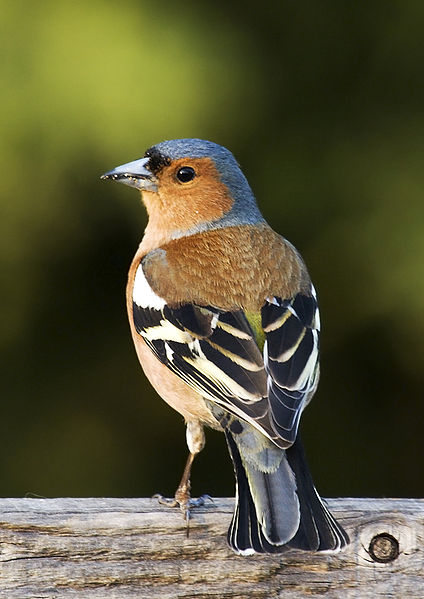The true finches are native to the Northern Hemisphere, with some members in the Neotropics and Hawaii. Several genera show hybridization, including some intergeneric hybrids, such as Red Crossbill (Loxia curvirostra) x Pine Siskin (Carduelis pinus) (Tallman & Zusi, 1984) and I’iwi (Vestiaria coccinea) x Apapane (Himatione sanguinea) (Knowlton et al., 2014).
Crosses between Canary (Serinus canaria) races have been used to study the development and genetics of song learning (Okanoya, Dooling & Downing, 1990). Furthermore, Canaries have also been crossed with Goldfinch (Carduelis carduelis) to study song (Güttinger & Clauss, 1982). These hybrids are sterile due to problematic spermatogenesis (Swan, 1985).
Carduelis
Two species of Redpoll (C. flammea and C. hornemanni) are known to hybridize (Baldwin, 1961). Whether the extensive phenotypic variability of these birds is influenced by hybridization is still unknown, despite intensive morphological (Seutin, Boag & Ratcliffe, 1992) and genetic (Seutin, Ratcliffe & Boag, 1995) studies.
Fringilla
The northernmost region of the Caucasus houses a hybrid population of two Chaffinch subspecies, F. coelebs caucasica and F. c. solomkoi (Tsvelykh, 2003; Tsvelykh, 2011)
Loxia
A genetic study based on mtDNA and microsatellites detected a lack of divergence between three Loxia species (L. curvirostra, L. pytyopsittacus and L. scotica) (Piertney, Summers & Marquiss, 2001). Since these species mate assortatively, the low divergence is probably due to small amounts of gene flow following occasional hybridization (Summers, Dawson & Phillips, 2007).

Red Crossbill (Loxia curvirostra)
Leucosticte
A phylogenomic study found introgression between several North American taxa of the rosy-finches (Funk et al., 2020), confirming previous findings based on a few genes (Drovetski et al. 2009).
Spinus
South American siskins (genus Spinus) are a group of 11 species that diversified about 550,000 years ago. Sympatric species share identical haplotypes, suggesting hybridization (Beckman & Witt, 2015). Further analyses revealed introgression between several species, namely between hooded siskin (Spinus magellanicus) and the following three species: black siskin (S. atratus), thick-billed siskin (S. crassirostris), and yellow-rumped siskin (S. uropygialis). Most of these introgression events probably occurred in the past, around the time these species diversified. However, there might also be recent introgression in Bolivia between hooded siskin and black siskin (Beckman et al, 2018).
Phylogenetic analysis of the Pine Siskin (S. pinus) complex revealed possible introgression between one subspecies (S. p. perplexus) and the Black-capped Siskin (S. atriceps) (Alvarez et al., 2015).

Pine Siskin (S. pinus)
References
Alvarez, S., Salter, J. F., McCormack, J. E. & Milá, B. (2015). Speciation in mountain refugia: phylogeography and demographic history of the pine siskin and black‐capped siskin complex. Journal of Avian Biology.
Baldwin, P. (1961). Distribution, overlap, and hybridization of two species of redpolls in Alaska. Bull. Ecol. Soc. Am 42, 152.
Beckman, E.J. & Witt, C.C. (2015) Phylogeny and biogeography of the New World siskins and goldfinches: Rapid, recent diversification in the Central Andes. Molecular Phylogenetics and Evolution 87, 28-45.
Beckman, E.J., Benham, P.M., Cheviron, Z.A. & Witt, C.C. (2018) Detecting introgression despite phylogenetic uncertainty: the case of the South American siskins. Molecular Ecology.
Drovetski, S. V., Zink, R. M., & Mode, N. A. (2009). Patchy distributions belie morphological and genetic homogeneity in rosy-finches. Molecular Phylogenetics and Evolution, 50(3), 437-445.
Funk, E. R., Spellman, G. M., Winker, K., Withrow, J. J., Ruegg, K. C., Zavaleta, E., & Taylor, S. A. (2021). Phylogenomic data reveal widespread introgression across the range of an alpine and arctic specialist. Systematic Biology, 70(3), 527-541.
Güttinger, H. R. & Clauss, G. (1982). Der gesangsaufbau von stieglitz-kanarienbastarden (Carduelis carduelis× Serinus canaria) im vergleich zu den elternarten. Journal für Ornithologie 123, 269-286.
Knowlton, J. L., Flaspohler, D. J., Mcinerney, N. C. R. & Fleischer, R. C. (2014). First Record of Hybridization in the Hawaiian Honeycreepers: ‘I’iwi (Vestiaria coccinea) X ‘Apapane (Himatione sanguinea). Wilson Journal of Ornithology 126, 562-568.
Okanoya, K., Dooling, R. J. & Downing, J. D. (1990). Hearing and Vocalizations in Hybrid Waterslager-Roller Canaries (Serinus-Canarius). Hearing Research 46, 271-276.
Piertney, S. B., Summers, R. & Marquiss, M. (2001). Microsatellite and mitochondrial DNA homogeneity among phenotypically diverse crossbill taxa in the UK. Proceedings of the Royal Society B-Biological Sciences 268, 1511-1517.
Seutin, G., Boag, P. T. & Ratcliffe, L. M. (1992). Plumage Variability in Redpolls from Churchill, Manitoba. Auk 109, 771-785.
Seutin, G., Ratcliffe, L. M. & Boag, P. T. (1995). Mitochondrial-DNA Homogeneity in the Phenotypically Diverse Redpoll Finch Complex (Aves, Carduelinae, Carduelis-Flammea-Hornemanni). Evolution 49, 962-973.
Summers, R. W., Dawson, R. J. G. & Phillips, R. E. (2007). Assortative mating and patterns of inheritance indicate that the three crossbill taxa in Scotland are species. Journal of Avian Biology 38, 153-162.
Swan, M. A. (1985). Transmission Electron-Microscopy of Impaired Spermatogenesis in an Avian Hybrid. Gamete Research 12, 357-371.
Tallman, D. A. & Zusi, R. L. (1984). A Hybrid Red Crossbill-Pine Siskin (Loxia-Curvirostra X Carduelis-Pinus) and Speculations on the Evolution of Loxia. Auk 101, 155-158.
Tsvelykh, A. (2003). Comparative analysis and distribution of the Chaffinch Fringilla coelebs (Aves, Fringillidae) subspecies from the Crimea, Caucasus and Transcaspian region. Zoologichesky zhurnal 82, 1250-1257.
Tsvelykh, A. (2011). Origin of hybrid population of crimean (fringilla coelebs solomkoi) and nominaltve (fringilla coelebs coelebs) chaffinch subspecies (passeriformes, fringillidae) on the northern coast of the sea of azov. Zoologichesky zhurnal 82, 1250-1257.


[…] Fringillidae […]